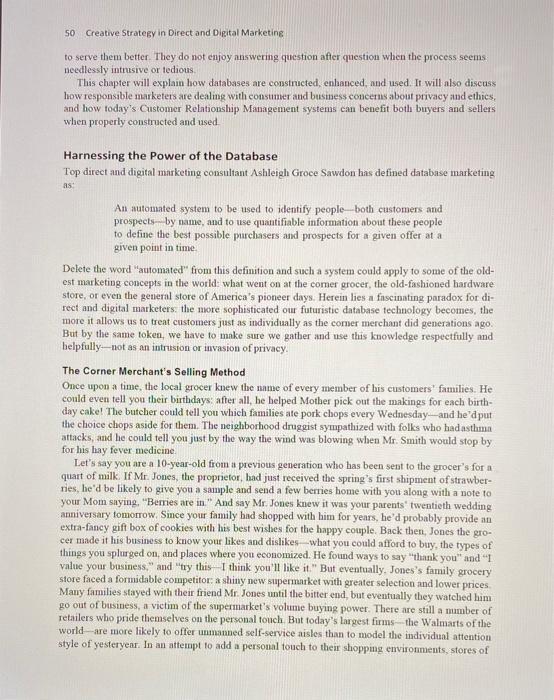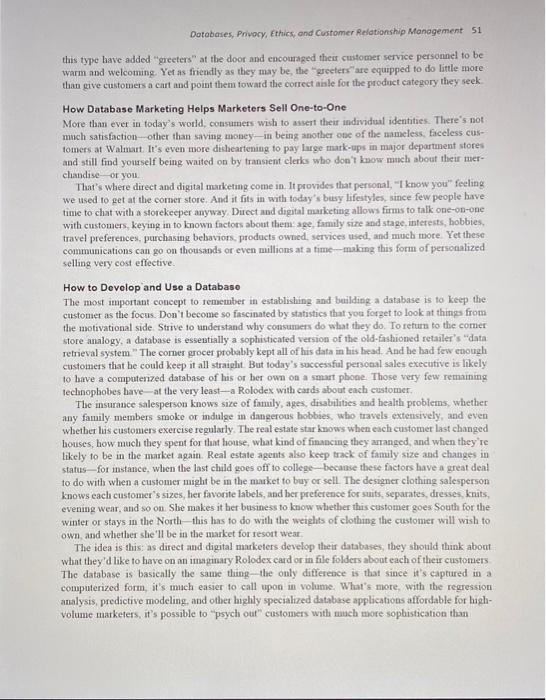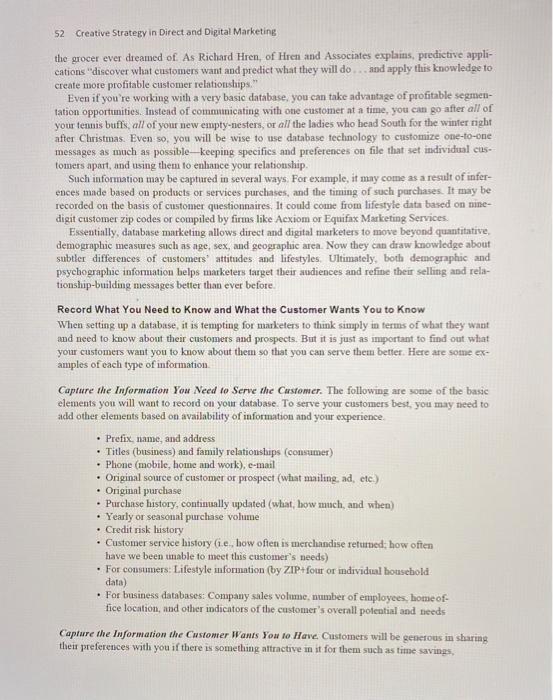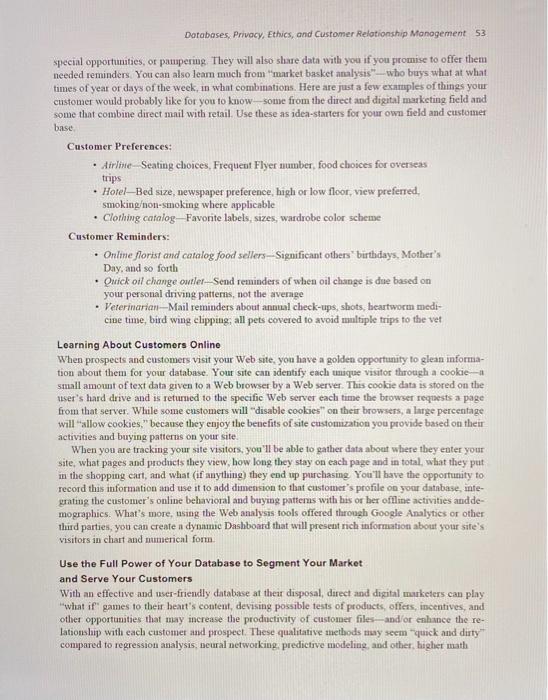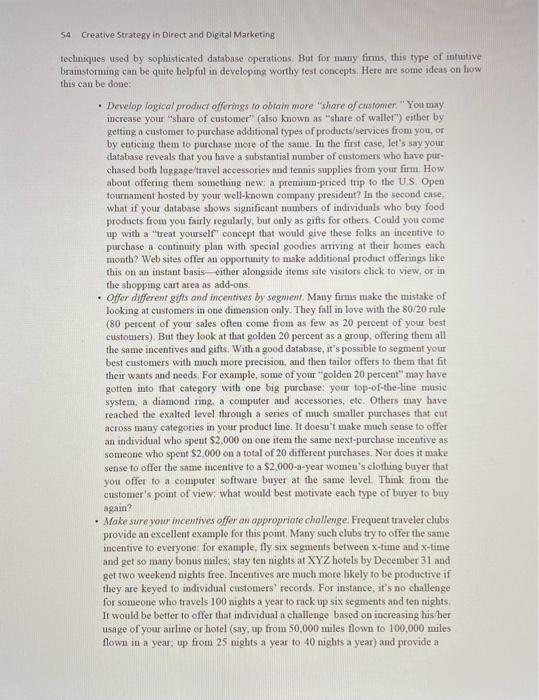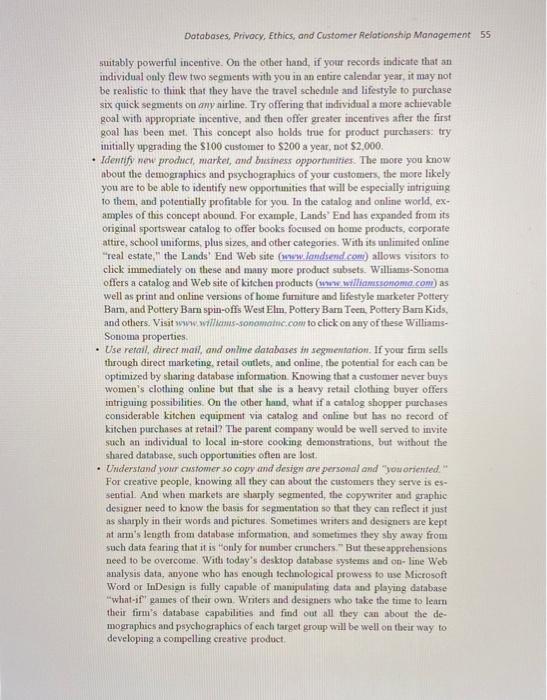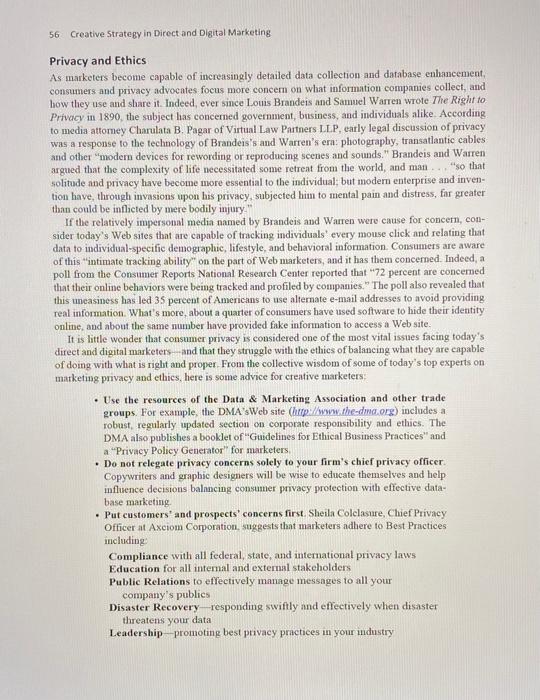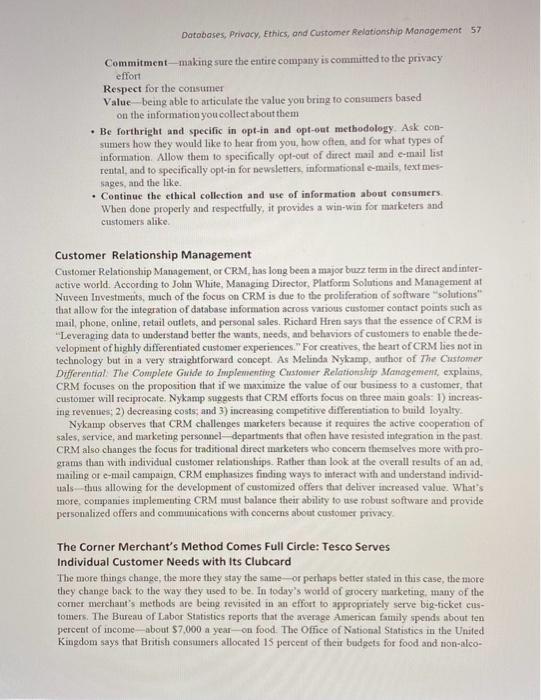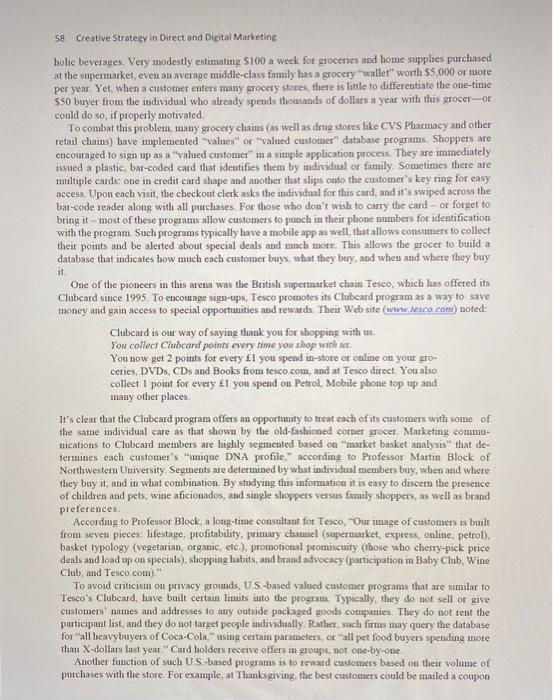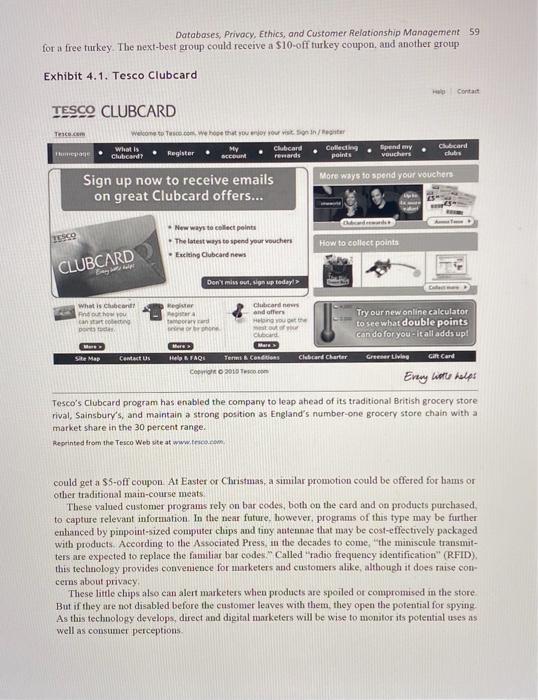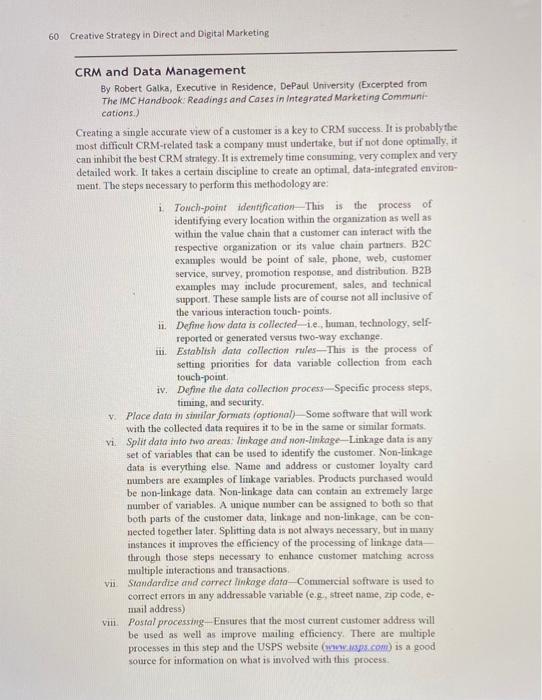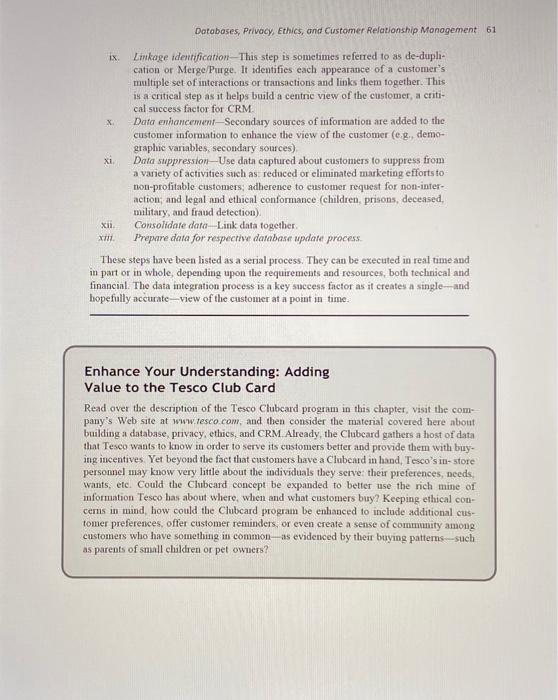Could the Clubcard concept be expanded to better use the rich mine of information Tesco has about where, when and what customers buy? Keeping ethical concerns in mind, how could the Clubcard program be enhanced to include additional customer preferences, offer customer reminders, or even create a sense of community among customers who have something in common---as evidenced by their buying patterns---such as parents of small children or pet owners?
Databases have become so essential to direct and digital marketers that the terms "direct marketing" and "database marketing" are used interchangeably, Yet as manketers become ever more sophisticated aboat what they can collect and how they can cross-reference that information with other sotrees of data, concens about privacy, efhics, and the effectiveness of customer relationship management inevitably arise. Indeed, as Emily Yellin reported in her book, Your Call Is (Not That) Important to Us, the Customer Rage Study (sponsored by Customer Care Measurement and Coaching, and Arizona State University), 68 percent of customers lad expenienced "customer rage" in the previous year. Yellin noted that according to this study, 90 percent of "enaged customers" shared their stories with other consumers, and 77 percent complained to the company that caused the problem. As a result of that customer complaint, 57 percent decided never to do business with the company again, while 28 percent "yelled or raised their voice" at a company employee, 8 percent "cursed," and 8 percent "threatened legal action " Later studies showed that 15 percent of complaining customers "wanted revenge" against the offending company, while only 1 pereent reported ever getting it. The chirf conclusion of the report is that "U.S. companies are driving their customers eracy." All direct and digital matketing involves the use or creation of a database, or store of information about customers and prospects, Some direct marketing media, such as direct mail, e-mail, mobile maketing, and outbound telephone makketing, require a database of customers and/or prospects who will receive mail, e-mail, texts, or phone calls. Other media, sach as magazines, newspapers, radio television, and the Web, rely upon prospects to identify themselves when they see or hear about offers that appeal to them. Once these prospects have "raised their hands" by inquiring or making a purchase, their names, addresses, and other vital information are added to the database. From that point on, the database can be enhanced and enriched as castomer actions and preferences are layered on from both internal and external sources. But considering the results of the Customer Rage Study, it is crystal clear that all of this must be done with customer satisfaction and customer privacy concetms firmly in mind. Customers appreciate what they perceive as respectfil suggestions on the part of marketers. They like the fact that companies recognize them as individuals and can pull up or provide helpfil information for them or abont them at every touch point (online; phone, face-fo-face, ete.). They do not appreciate the "creepy sense" that marketers are recording and reacting to their every move, ouline and offline. Cusfomers will answer questions about themselves when they percerve that the marketer will wse that information 49 50 Creative Strategy in Direct and Digital Marketing to serve them better. They do not enjoy answering question affer question when the process seems: needlessiy intnasive or tedious This chapter will explain how databases are constructed, enlanced, and used. It will also discuss how responsable narketers are dealing with constumer and business concerus about privacy and ethics. and how today's Gustomer Relationship Management systens ean benefit both buyers and sellers when properly constructed and used Harnessing the Power of the Database Top direct and digital marketing consultant Ashleigh Groce Sawdon has defined database marketing as: An automated system to be used to identify people-both customers and prospects-by name, and to use quantifiable information about these people to defune the best possible parchasers and prospects for a given offer at a given point in time. Delete the word "automated" from this definition and such a system could apply to some of the oldest marketing concepts in the world: what went on at the comer grocer, the old-fashioned hardware: store, or even the general store of America's pioneer days. Herein lies a fuscinating paradox for direct and digital marketers. the nore sophisticated our futuristic database technology becomes, the more it allows us to treat customers just as individually as the cormer merchant did generations ago. But by the same token, we have to make sure we gather and use this knowledge respectfully and belpfully-not as an intrusion or invasion of privacy. The Corner Merchant's Selling Method Once upon a time, the local grocer knew the name of every member of his customer't families. He could even tell you their birthdays: after all, be helped Mother pick out the makings for each birthday cake! The butcher could tell you which families ate pork chops every Wednesday-and he'd put the choice chops aside for them. The neighborhood draggist sympathized with folks who hadasthma attacks, and he could tell you just by the way the wind was blowing when Mr. Smith would stop by for his hay fever medicine. Let's say you are a 10 -year-old from a previous generation who has been sent to the grocer's for a quart of milk. If Mr. Jones, the proprietor, had just received the spring's first shipment of strawberres, he'd be likely to give you a sample and send a few beries home with you along with a note to your Mom saying, "Berries are in." And say Mr. Jones knew it was your parents" twentieth wedding anniversary tomorrow, Since you family had shopped with him for years, he'd probably provide an extra-fancy gift box of cookies with his best wishes for the happy couple. Back then, Jones the grocer made it his business to know your likes and dislikes what you could afford to buy, the types of things you splurged on, and places where you economized. He found ways to say "thank you" and "1 value your business," and "try this I think you'll like it." But cventually, Jones's family grocery store faced a formidable competitor a shiny new supermarket with greater selection and lower prices Many families stayed with their friend Mr. Jones until the bitter end, bat eventually they watched him go out of business, a victim of the supermarket's volume buying power. There are stall a number of retailers who pride themselves on the personal touch. But today's largest firms-the Walmarts of the world-are more likely to offer ummanned self-service aisles than to model the individual attention style of yesteryear. In an attempt to add a personal touch to their shoppmg emvironments, stores of 52 Creative Strategy in Direct and Digital Marketing the grocer ever dreamed of. As Richard Hren, of Hren and Associates explains, predictive applieations "discover what customers want and predict what they will do ... and apply this knowledge to create mote profitable customer relatiotwhips." Even if you're working with a very basic database, you can take advantage of profitable segmentation opportumities. Instead of communicating with obe customer at a time, you can go-after all of your teinis buffs, all of your new empty-nesters, or all the ladies who head South for the winter nght after Christmas. Even so, you will be wise to use database technology to customize one-to-one messages as much as possible-keeping specifics and preferences on file that set individual customers apart, and using them to enlance your relationship. Such information may be captured in several ways. For example, it may come as a result of inferences made based on products or services purchases, and the timing of such parchases. It may be recorded on the basis of customer questionnaires, It could come from lifestyle dita based on nimedigit customer zip codes or compiled by firms like Acxiom or Equifax Marketing Services. Fssentially, database marketing allows direct and digital marketers to move beyond quantitative, demographic measures such as age, sex, and geograpluc area. Now they can draw knowledge about subtler differences of erstomers' attitudes and lifestyles, Ultimately, both demographic and psychographic information belps marketers farget their audiences and refine their sellitg and relationship-building messages better than ever before Record What You Need to Know and What the Customer Wants You to Know When setting up a database, it is tempting for marketers to think simply in terms of what they want and need to know about their customers and prospects. But it is just as important to find out what your customers want you to know about them so that you can serve them better. Here are some examples of each type of information. Capture the Information You Need to Serve the Castomer. The following are some of the basic elements you will want to record on your database. To serve your castomers best, you may need to add other elements based on availability of information and your experience. - Prefix name, and address - Titles (business) and family relationships (consumer) - Phone (mobile, home and work), e-mail - Original source of customer or prospect (what mailing, ad, ctc) - Original purchase - Purchase history, continsally updated (what, bow much, and when) - Yearly or seasonal purchase volume - Credit risk history - Customer service history (i.e, how often is merchandise retuined, how oftem have we been unable to meet this customer's needs) - For cousumers: Lifestyle information (by ZIP+four or individual houschold data) - For business databases: Company sales volume, number of employees, home office location, and other indicators of the customer's overall polential and needs Capture the Information the Customer Wants You to Have Customers will be generous im sharing theif preferences with you if there is something attractive in it for them such as time savings, reative strategy in Direct and Digital Marketing Zues used by sophisticated database operations: But for many firms, this type of intui orming can be quite helpful in developing worthy test concepts. Here are some ideas on be done: - Develop logical producr offerings to obvain more "share of cusfomer. "Youmay increase your "share of customer" (also known as "share of wallet") either by getting a customer to purchase additional types of products/services from you, or by enticung them to purchase more of the same. In the first case, let's say your database reveals that you have a substantial number of customers who have purchased both luggage travel accessories and tenmis supplies from your firm How about offering them something new; a premium-priced trip to the U.S. Opet tournament hosted by your well-known company president? In the second case, what if your database shows siauficant numbers of individuals who bery food products from you fairly regularly, but only as gifts for others. Could you come up with a "treat yourself" concept that would give these folks an incentive to purchase a contimuty plan with special goodies arriving at their homes each month? Web sites offer an opportumity to make additional product offerings like this on an instant basis - either alongside items site visitors click to view, or in the shopping cart area as add-ons. - Offer different gifts and incentives by segnent. Many firms make the mistake of looking at customers in one dimension only. They fall in love with the 8020 rule (80 percent of your sales often come from as few as 20 percent of your best customers). But they look at that golden 20 pereent as a group, offering them all the same incentives and gifts. With a good database, it's possible to segment your best customers with much more precision, and then talor offers to them that fit their wants and needs. For example, some of your "golden 20 percent" may have gotten into that category with one big purchase: your top-of-the-line music system, a diamond ring, a computer and accessonies, etc. Others may have reached the exalted level through a series of much smaller purchases that cut across many categories in your product line. It doesu't make much sense to offer an individual who spent $2,000 on one item the same next-purchase incentive as someone who spent $2,000 on a total of 20 different purchases, Nor does it make sense to offer the same incentive to a $2,000-a-year women's clothing buyer that you offer to a computer softwate buyer at the same level. Think from the customer's point of view: What would best motivate each type of buyer to buy again? - Make sure your incentives offer an appropriate challenge. Frequent traveler clubs provide an excellent example for this point. Many such clubs try to offer the same incentive to everyone: for example, fly six segments between x-time and x-time and get so many bonus miles; stay ten nights at XYZ hotels by December 31 and get two weekend uights free. Incentives are much more likely to be productive if they are keyed to individual customers' records. For instance, it's no challenge for someone who travels 100 nights a year to rack up six segments and ten nights. It would be better to offer that individual a challenge based on increasing hisher nsage of your airline or hotel (say, up from 50,000 miles Aown to 100,000 miles flown in a year, up from 25 nights a year to 40 mights a year) and provide a Dotabases, Privocy, Ethics, and Customer Relotionship Management suitably powerfnl incentive. On the other hand, if your records indicate that an individual oaly flew two segments with you in an entire calendar year, it may not be realistic to think that they have the travel schedale and lifestyle to parchase six quick segments on any airline. Iry offering that individual a more achievable goal with appropriate incentive, and then offer greater incentives after the first goal has been met. This concept also holds true for product purchasers. try initially upgrading the $100 customer to $200 a year, not $2,000. - Identify new product, markel, and business opporhumiries. The more you know about the demographics and psychographics of your customers, the more likely you are to be able to identify new opportunities that will be especially intrigting to them, and potentially profitable for you. In the catalog and onlime world, examples of this concept abound. For example, Lands' Fnd has expanded from its original sportswear catalog to offer books focused on home products, eorporate attire, school umiforms, plus sizes, and other categories, With its umlimited online "real estate," the Lands' End Web site (anww londsendicam) allows visitors to click immediately on these and many more product subsets. Walliams-Sonoma offers a catalog and Web site of kitehen products (wwe williamsionoma, com) as well as print and online versions of home furmiture and lifestyle marketer Pottery Bam, and Pottery Barm spin-offs West Elm, Pottery Barn Teen. Pottery Bam Kids, and others. Visit umen withioms-sonamatrec.com to click on any of these WilliamsSonoma properties. - Use retail, direct mait, and online databases in segmentarion. If your firm sclls through direct marketing, retail outlets, and online, the potential for each can be optimized by sharing database information. Knowing that a customer never buyz women's clothing online but that she is a beavy retail clothing buyet offers intriguing possibilities. On the other hand, what if a catalog shopper parchases considerable kitchen equipment via catalog and online but has no record of kitchen purchases at retail? The parent company would be well served to imvite such an individual to local in-store cooking demonstrations, but without the shared databise, such opportumities often are lost. - Understand your customer so copy and design ane personal and "youroriented." For creative people. knowing all they can about the customers they serve is essential And when markets are sharply segmented, the eopywriter and graphic designer need to know the basis for segmentation so that they can reflect it just as sharply in their words and pichures. Sometimes writers and designers are kept It am's length from database information, and sometimes they shy away from such data fearing that it is "only for mumber cruachers." But theseapprehensions need to be overcome. With today's desktop database systems and on- line Web analysis data, anyone who has enough fechnological prowess to me Mictosoft Word or InDesign is fully capable of manipalatimg data and playing database "what-if" gamies of their own. Writers and designers who take the time to learn their firm's database eapabilities and fund out all they can about the demographics and psychogaphics of each target group will be well on their way to developang a compelling creative product. 56 Creative Strategy in Direct and Digital Marketing Privacy and Ethics As marketers become capable of increasingly detailed data collection and database enhancement, consumers and privacy advocates focus more concerm on what information companies collect, and how they use and share it. Indeed, ever since Louis Brandeis and Samuel Warren wrote The Right to Privacy in 1890 , the subject has concerned government, business, and individuals alike. According to media attomey Charulata B. Pagar of Virtual Law Partners L.P, eatly legal discussion of privacy was a response to the technology of Brandeis's and Warren's era: photography, transatlantic cables and other "modern devices for rewording or reproducing scenes and sounds." Brandeis and Warren argued that the complexity of life necessitated some retreat from the world, and man ... "so that solitude and privacy have become more essential to the individual; but modern enterprise and invention have, through imvasions upon his privacy, subjected him to mental pain and distress, far greater than could be inflicted by mere bodily injury." If the relatively impersonal media named by Brandeis and Warren were cause for concern, consider today's Web sites that are capable of tracking individuals' every mouse click and relating that data to individual-specific demographic, lifestyle, and behavioral information. Consumers are aware of this "intimate tracking ability" on the part of Web marketers, and it has them concerned. Indeed, a poll from the Consumer Reports National Research Center reported that "72 percent are concerned that their onlme behaviors were being tracked and profiled by companies. The poll also revealed that this uneasiness has led 35 pereent of Americans to use alternate e-mail addresses to avoid providing real information. What's more, about a quarter of consumers have used software to hide their identity online, and about the same number have provided fake information to access a Web site. It is little wonder that consumer privacy is considered one of the most vital issues facing today's direct and digital marketers-and that they struggle with the ethics of balancing what they are capable of doing with what is right and proper. From the collective wisdom of some of today's top experts on matketing privacy and ethics, here is some advice for creafive marketers: - Use the resources of the Data \& Marketing Association and other trade groups. For example, the DMA'sWeb site (hrrp:/hww therdwgorg) includes a robust, regularly updated section on corporate responstbility and ethics. The DMA also publishes a booklet of "Guidelines for Ethical Business Practices" and a "Privacy Policy Genetator" for marketers - Do not relegate privacy concerns solely to your firm's chicf privacy officer. Copywriters and graphic designers will be wise to educate themselves and help influence decisions balnncing consumer privacy jrotection with effective database marketing. - Put customers' and prospects' concerns first. Sheila Colclasure, Chief Privacy Officer at Axciom Corporation, suggests that marketers adhere to Best Practices inclusing: Compliance with all federal, state, and imternational privacy laws Education for all internal and exterual stakeholders Public Relations to effectively manage messages to all your company's publics Disaster Recovery responding swiftly and effectively when disaster threatens your data Leadership promoting best ptivacy practices in your industry Datobases, Privocy, Ethics, and Cuntamer Relationstip Marggement 57 Commitment-making sure the entire compuny is committed to the privacy effort Respect for the consumey Value - being able to articulate the value you bring to consumers based on the information you collect about them - Be forthright and specific in opt-in and opt-ont methodology. Ask conBe forthright and specific in opt-in and opt-oat methodology. Ask coninformation. Allow them to specifically opt-out of direct mall and e-mail list rental, and to specifically opt-in for newsletters, informational e-mails, fext messages, and the like. - Continue the cthical collection and use of information about consumers When done properly and respectfully, it prowides a win-win for marketers and cistomers alike. Customer Relationship Management Customer Relationship Management, or CRM, has long been a major buzz term in the direct and interactive world. According to John White, Managing Director, Platform Solutions and Management at Nuveen Investments, much of the focus on CRM is due to the proliferation of software "solutions" that allow for the integration of database information across various custotner contact points such as maal, phone, online, retail outlets, and personal sales. Richard Hren says that the essence of CRM is Leveraging data to understand better the wants, needs, and behaviors of customers to enable the development of highly differentiated customer experiences." For creatives, the beart of CRM hes not in technology but in a very straightforward concept. As Melinda Nykamp, author of The Crastomer Differential: The Complete Gulde to Implewenting Customer Relatfonship Managenent, explains, CRM focuses on the proposition that if we maximuze the value of our business to a custorser, that customer will recipocate. Nykamp suggests that CRM efforts focus on three main goals: 1) increasing revenues; 2) decreasing costs; and 3 ) increasing competitive differentiation to build loyalry: Nykamp observes that CRM challenges marketers because it requires the active cooperation of sales, service, and marketing personael - departments that often have resisted integration in the past CRM also changes the focus for traditional direct marketers who concern themselves more with programs than with individual customer relationships. Rather than look at the overall results of an ad, mailing or e-mail eampaign. CRM emphasizes finding ways to interact with and understand individuals thus allowing for the development of customized offers that deliver increased value. What's more, companies implementing CRM must balance their ability to tuse robust software and provide personalized offers and conmanications with concerns about customer privacy. The Corner Merchant's Method Comes Full Circle: Tesco Serves Individual Customer Needs with Its Clubcard The more things change, the more they stay the same or perhaps berter stated in this case, the more they change back to the way they used to be. In today's wotld of zrocery marketing, many of the corner merchant's methods are being revisited in an effout to appropriafely serve big-ticket castomers. The Bureau of Labor Statistics reports that the average American family spends about ten percent of income-about $7,000 a year-on food. The Office of National Statistics in the United Kingdom says that British consumers allocated 15 percent of thear budgets for food and non-alco- 58 Creative Strategy in Direct and Digital Marketing: holic beverages. Very modestly estimatimg $100 a week for groceries and home supphes purchased at the supenmarket, even an avemge mudde-class family has a grocery "wallet" worth 55,000 or more per year. Yet, when a customer enters many grocery stores, there is liftle to differentiate the one-time $50 buyer from the individual who already spends thousands of dollarsa year with this grocer-or could do so, if properly motivated To combat this problem, many grocery chains (as well as drug stores like CVS Pharmacy and other retail chains) have implemented "values" or "valned customer" database programs. Shoppers are encouraged to sign up as a "valued customer" in a simple application process. They are ummediately issued a plastic, bar-coded card that identifies them by individual or family. Sometimes there are multiple cards, one in credit card shape and another that slips onto the customer's key ring for easy access. Upon each visit, the checkont clerk asks the individual for this card, and it's swiped across the bar-code reader along with all purcliases. For those who don't wish to carry the card - or forget to bting it - most of these prograns allow customers to peinch in their phone numbers for identification with the program. Such programs typically have a mobile app as well, that allows constumers to collect their points and be alerted about special deals and much more. This allows the procer to build a database that indicates how much each customer buys, what they buy, and when and where they buy it One of the psoneers in this arena was the Bnitish supermarket chain Tesco, which has offered its Clubcard since 1995 . To encourage sign-ups. Tesco prompotes its Clubcard program as a way to save money and gain access to spectal opportunities asd rewards. Their Web site (www tesco.com) noted: Clubcard is our way of saying thank you for shopping with us. Yon collecr Cinbcard points every time you shop with as. You now get 2 points for every fl you spend in-store or online on your groceries, DVDs, CDs and Books from tesco.com, and at Tesco direct. You also collect 1 point for every 21 you spend on Pefrol. Mobile phone top up and many other places: It's clear that the Clubcard program offers an opportunity to treat each of its customers with some of the same individual care as that shown by the old-fastaioned corner grocer. Marketing communications to Clubcard members are highly segmented based on "murket basket analysis" that determines each customer's "tmique DNA profile," according to Professor Martin Block of Northwestern University. Segments are determined by what individual members buy, when and where they buy it, and in what combination. By studying this information it is easy to discern the presence of children and pets, wine aficionados, and single shoppers versus family shoppers, as well as brand preferences. According to Professor Block, a long-time consultant for Tesco, Onm image of customers is built from seven pieces: lifestage, profitability, primary channel (sapermatket, express, online, petrol). basket typology (vegetarian, organic, etc.). promoticaal promiscaity (those who cherry-pick price deals and load up on specials), shopping habits, and brand advocacy (participation in Baby Club, Wine Club, and Tesco.com)." To avoid criticism on privacy grounds, U.S.-based valned customer programs that are samilar to Tesco's Clubcard, have buit certain limits iuto the program. Typically, they do not sell or give customers' names and addresses to any outside packaged goods companies. They do not rent the paricipant list, and they do not taget people individually. Rathet, sach firms may query the database for "all heavybuyers of Coca-Cola," using certain parameters, or "all pet food buyers spending more than X-dollars last year "Card holders receive offers in groups, not one-by-one Another function of such U,S-based progams is to reward customers based on their volmue of purchases with the store. For example, at Thanksgiving, the best customers could be muiled a coupon Databases, Privacy, Ethics, and Customer Relationship Management 59 for a free turkey. The next-best group could receive a $10-off turkey coupon, and another-group Exhibit 4.1. Tesco Clubcard IESCO CLUBCARD Tesco's Clubcard program has enabled the company to leap ahead of its traditional British grocery store rival, Sainsbury's, and maintain a strong position as England's number-one grocery store chain with a market share in the 30 percent range. could get a \$5-off coupon. At Easter or Christmas, a similar promotion could be offered for hams or other thaditional main-course meats. These valued customer progams rely on bar codes, both on the card and on products purchased. to capture relevant information. In the near future, however, progams of this type may be further enhanced by pinpoint-sized computer chips and tiny antennae that may be cost-effectively packaged with products. According to the Associated Press, in the decades to come, "the miniscule transmitters are expected to replace the familiar bar codes " Called "radio frequency identification" (RFID). this technology provides convenience for marketers and customers alike, although it does raise concerns about privacy. These little chips also can alert marketers when products are spoiled ot compromised in the store But if they are not disabled before the customer leaves with them, they open the potential for spying. As this technology develops, direct and digital marketers will be wise to monitor its potential uses as well as consumer perceptions. eative Strategy in Direct and Digital Marketing RM and Data Management By Robert Galka, Executive in Residence, DePaul University (Excerpted from The IMC Handbook: Readings and Cases in integrated Marketing Communtcations.) Greating a single accurate view of a customer is a key to CRM success. If is probablythe nost difficult CRM-related task a company must undertake, but if not done optimally, it an inhtbit the best CRM strategy. It is extremely time consuming, very complex and very letailed work. It takes a certain discipline to create an optimal, data-integrated environment, The steps necessary to perform this methodology are: 1. Tonch-point ideutffication-This is the process of identifying every location within the organization as well as within the value chain that a customer can internct with the respective organization or its value chain partuers. B2C examples would be point of sale, phone, web, customer service, survey, promotion response, and distribution. B2B examples uay include procurement, sales, and technical stpport. These sample lists are of course not all inclusive of the various interaction touch- points. ii. Define how data is collected i.e., human, technology, selfreported or generated versus two-way exchange. iii. Estabish data collection rales-This is the process of setting priorities for data variable collection from each touch-point. iv. Define the data collection process-Specific process steps: timing, and security. v. Place dafa in sinilar formats (optional)_Some software that will work with the collected data requires it to be in the same or sumilar formats: vi. Split data into hvo areas. limkage and non-linkage-Linkage data is any set of variables that can be itsed to identify the customer. Non-limkage dats is everything else. Name and address or customer loyalty card numbers are examples of linkage variables. Products purchased would be non-linkage data. Non-linkage data can contain an extremely large number of variables. A umique number can be assigned to both so that both parts of the customer data, linkage and non-linknge, can be connected together later. Splitting data is not always necessary, but in mamy instances it improves the efficiency of the processing of limkage datathrough those steps necessary to enhaace customer matching across multiple interactions and transactions, vii Siandardize and corret linkage data-Commercial sofrware is used to correct errors in any addressable variable (e.g, street name, zip code, cwasl address) vii. Posial processing Ensures that the most current customer address will be used as well as improve maling efficiency. There are multiple processes in this step and the USPS website (wny anys come) is a good source for information on what is involved with this process Databases, Privag, Ethics, and Customer Relationship Management 61 ix. Linkege identification-This-step is sometimes referted to as de-duplication or Merge/Purge, It identifies each appearance of a customer's multiple set of interactions or transactions and links them together. This is a critical step as it helps build a centric view of the customer, a critical success factor for CRM. x. Data emiancemen-Secondary sources of information are added to the customer information to enhance the view of the customer (e.g, demographic variables, secondary sources). xi. Dafa suppression-Use data captured about customers to suppress from a variety of activities such as: reduced or eliminated marketing efforts to non-profitable customers; adherence to customer request for non-interaction; and legal and ethical conformance (children, prisons, deceased, military, and fraud detection). xii. Consolidate dato - Link data together. xii. Prepare data for respective database update process. These steps have been listed as a serial process. They can be executed in real time and in part or in whole, depending upon the requirements and resources, both technical and financial. The data integration process is a key success fuctor as it creates a single-and hopefully accurate-view of the castomer at a point in time. Enhance Your Understanding: Adding Value to the Tesco Club Card Read over the description of the Tesco Clubcard program in this chapter, visit the company's Web site at www.tesco.com, and then consider the material covered here about building a database, privacy, ethics, and CRM Already, the Clubcard gathers a host of data that Tesco waats to know in order to serve its enstomers bettet and provide them with buying incentives. Yet beyoud the fact that customers have a Clubeard in hand, Tesco's in-store personnel may know very little about the individuals they serve: their preferences, needs. wants, etc. Could the Clubcard concept be expanded to better use the rich mine of information Teseo bas about where, when and what customers buy? Keeping ethical concerns in mind, how could the Clubcard program be enhanced to include additional customer preferences, offer customer rerninders, or even create a sense of community among customers who have something in common - as evidenced by their buying patterns - such as parents of small children or pet owners

